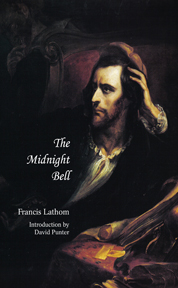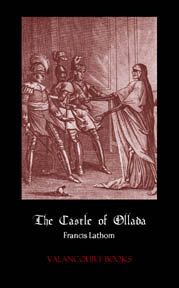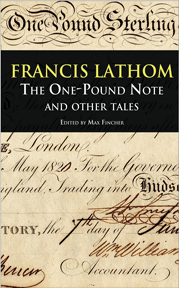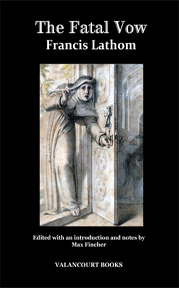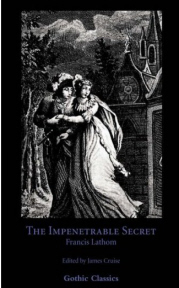
The Impenetrable Secret, Find it Out! (1805)
Francis Lathom, Edited by James Cruise
Averilla del Alvaretti is set to marry the Conte della Piacca, forced into the union by her unfeeling uncle, when she meets the handsome Sylvio di Rosalva and falls in love with him. But Sylvio's behaviour and origins are mysterious, and despite his professions of love, he abruptly breaks off the connection, sending Averilla a mortifying letter saying he never loved her.
Averilla marries the Conte della Piacca, who, she is pleased to find, is a kind and generous man, and not the tyrant she had imagined. Then, one night at a party with her husband, Averilla catches sight of Sylvio -- only he claims not to know her! Then, when Sylvio is summoned to court for allegedly breaking a promise to marry, and tells a tale different than the one he had told her, the mystery deepens. But there is more at stake in the trial than the broken marriage promise -- as the hearing unfolds, a terrible tale of poisoning, blackmail, and murder will be exposed!
A delightful blend of mystery, romance, and Shakespearean intrigue, with an undercurrent of Gothic horror, The Impenetrable Secret, Find it Out! is one of Francis Lathom's most enjoyable and lighthearted novels. Critically acclaimed on its initial release in 1805, the novel has been out of print since 1831. This edition includes a new introduction by James Cruise which addresses the recurring theme of secrecy in eighteenth century literature, and analyses Lathom's novel within this broader framework.
Francis Lathom, Edited by James Cruise
Averilla del Alvaretti is set to marry the Conte della Piacca, forced into the union by her unfeeling uncle, when she meets the handsome Sylvio di Rosalva and falls in love with him. But Sylvio's behaviour and origins are mysterious, and despite his professions of love, he abruptly breaks off the connection, sending Averilla a mortifying letter saying he never loved her.
Averilla marries the Conte della Piacca, who, she is pleased to find, is a kind and generous man, and not the tyrant she had imagined. Then, one night at a party with her husband, Averilla catches sight of Sylvio -- only he claims not to know her! Then, when Sylvio is summoned to court for allegedly breaking a promise to marry, and tells a tale different than the one he had told her, the mystery deepens. But there is more at stake in the trial than the broken marriage promise -- as the hearing unfolds, a terrible tale of poisoning, blackmail, and murder will be exposed!
A delightful blend of mystery, romance, and Shakespearean intrigue, with an undercurrent of Gothic horror, The Impenetrable Secret, Find it Out! is one of Francis Lathom's most enjoyable and lighthearted novels. Critically acclaimed on its initial release in 1805, the novel has been out of print since 1831. This edition includes a new introduction by James Cruise which addresses the recurring theme of secrecy in eighteenth century literature, and analyses Lathom's novel within this broader framework.
|
BOOK DETAILS
Trade paper ISBN-13: 978-0977784134 List Price: $17.99 U.S. Pages: 224 Published: 2006 |
|
ALSO AVAILABLE THROUGH ONLINE RETAILERS
MORE TITLES BY THIS AUTHOR
SEE THE COMPLETE LIST OF TITLES HERE
AUTHOR BIOGRAPHY
Francis Lathom (1774-1832) was born in July 1774 at Rotterdam to Henry and Sarah Lathom. Henry Lathom was a Norwich merchant engaged in business with the East India Company in Holland. Around 1777, the family returned to the vicinity of Norwich, and in the 1790s Lathom began to pen plays for the Theatre Royal Norwich, including the comedies All in a Bustle (1795) and The Dash of the Day (1800), the latter of which was acted to “universal applause” and ran into at least four editions. In 1795, Lathom published his first novel, The Castle of Ollada, a Gothic romance indebted to Ann Radcliffe’s The Mysteries of Udolpho (1794) and Walpole’s The Castle of Otranto (1764).
In 1797, Lathom married Diana Ganning, daughter of Daniel Ganning, a wealthy lawyer and landowner, with whom he had three children, Henry Daniel (b. 1799), Frederick (b. 1800), and Jessy Ann (b. 1803). The following year, he published what became his most famous novel, The Midnight Bell (1798), which was mentioned in Jane Austen’s Northanger Abbey (1818) and which was the only of Lathom’s novels reprinted in the 20th century. He followed this success with the satire Men and Manners (1799), described by critic Montague Summers as Lathom’s masterpiece and worthy of a young Dickens, and Mystery (1800), a curious mixture of the Gothic with epistolary domestic romance.
Around 1802 or 1803, under circumstances not yet known, Lathom left Norwich, perhaps for Scotland. Lathom’s father’s will provided him an annuity of £200 per year, provided that he relinquish custody of his children to Diana and have nothing more to do with them. Summers posited that Lathom’s removal from Norwich may have stemmed from a gay love affair, which, while not substantiated, may nonetheless be true.
Between 1802 and 1809, Lathom was extremely prolific, publishing the novels Astonishment!!! (1802), The Impenetrable Secret, Find it Out! (1805), The Mysterious Freebooter (1806), Human Beings (1807), The Fatal Vow (1807), The Unknown (1808), London, or, Truth Without Treason (1809), and The Romance of the Hebrides, or, Wonders Never Cease (1809). After 1809, he disappeared from the publishing scene and apparently travelled to America, where he visited New York and lived for a time in Philadelphia.
In 1820, Lathom returned to publishing, releasing Italian Mysteries and the collection The One-Pound Note and Other Tales. He continued to write throughout the remainder of the decade; these later works include Live and Learn (1823), in which the friendship between the two male characters was felt by Summers to be “clearly” queer in nature, as well as two additional collections of short stories and the novels Young John Bull (1828) and Mystic Events (1830). Lathom is said to have died in Fyvie, Aberdeenshire, Scotland in 1832.
In 1797, Lathom married Diana Ganning, daughter of Daniel Ganning, a wealthy lawyer and landowner, with whom he had three children, Henry Daniel (b. 1799), Frederick (b. 1800), and Jessy Ann (b. 1803). The following year, he published what became his most famous novel, The Midnight Bell (1798), which was mentioned in Jane Austen’s Northanger Abbey (1818) and which was the only of Lathom’s novels reprinted in the 20th century. He followed this success with the satire Men and Manners (1799), described by critic Montague Summers as Lathom’s masterpiece and worthy of a young Dickens, and Mystery (1800), a curious mixture of the Gothic with epistolary domestic romance.
Around 1802 or 1803, under circumstances not yet known, Lathom left Norwich, perhaps for Scotland. Lathom’s father’s will provided him an annuity of £200 per year, provided that he relinquish custody of his children to Diana and have nothing more to do with them. Summers posited that Lathom’s removal from Norwich may have stemmed from a gay love affair, which, while not substantiated, may nonetheless be true.
Between 1802 and 1809, Lathom was extremely prolific, publishing the novels Astonishment!!! (1802), The Impenetrable Secret, Find it Out! (1805), The Mysterious Freebooter (1806), Human Beings (1807), The Fatal Vow (1807), The Unknown (1808), London, or, Truth Without Treason (1809), and The Romance of the Hebrides, or, Wonders Never Cease (1809). After 1809, he disappeared from the publishing scene and apparently travelled to America, where he visited New York and lived for a time in Philadelphia.
In 1820, Lathom returned to publishing, releasing Italian Mysteries and the collection The One-Pound Note and Other Tales. He continued to write throughout the remainder of the decade; these later works include Live and Learn (1823), in which the friendship between the two male characters was felt by Summers to be “clearly” queer in nature, as well as two additional collections of short stories and the novels Young John Bull (1828) and Mystic Events (1830). Lathom is said to have died in Fyvie, Aberdeenshire, Scotland in 1832.

